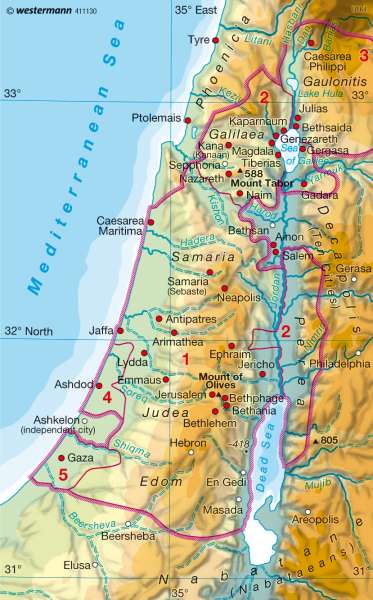Palestine in the age of Jesus
Israel
978-3-14-100790-9 | Page 100 | Ill. 1

Information
The reign of Herod in Palestine was a result of the Roman conquest of the Maccabees 63 BC at Pompey. Since 140BC, the ruling Maccabees had lost their political power in a period of internal conflict. The kingdom of Judea became a dependent, tax-paying client state of Rome. Herod, Commander of Galilee since 47 BC, was appointed by the Roman Senate as King of Judaea in 40 BC. Upon taking office, he began to extend its dominion. Jerusalem fell after bloody battles in 37 BC where notibly the Maccabee king, Antigonus, was beheaded. With conquests of further dominions, Herod almost reached the Davidic borders. When Herod died in 4 BC, his domain was divided with the majority falling to the eldest son Archelaus, ruler of Judea, Samaria and Idumea. A younger son, mentioned in the New Testament, Herod Antipas (who executed St. John the Baptist in 25 AD), ruled Perea and Galilee for over 40 years. Philip gave Gaulantis, Batanaia, Trachonitis Auranitis and the territories of the North (the region Azotus) to his sister Salome. The area around Gaza fell to the Roman province of Syria. The reign of Archelaus was not to last long. The hatred felt by Palestinians still living there against what was perceived as foreign rulers, Herodians, so intensified in parts of his kingdom, that he was dismissed after two years and banished to Gaul by Augustus. His empire was transformed into the province of Judea and was subordinated to a prefect. The Jews were obliged to pay for land and poll tax.Herod the Great
The name of Herod is inextricably tied in Christianity with the "Massacre of the Innocents". Moreover, Herod ordered all his opponents to be eliminated, including his own sons, eight marriages and one of his wives. However, he managed a balance between the Jewish and Roman interests. At the same time, the country experienced a significant economic upturn during his reign including the creation of magnificent monuments and temples throughout the country. Samaria was newly rebuilt as "Augustus Town" and together with Paneas, had magnificent temples in Augustus. There was a settlement with a precious garden near Jerusalem and the Dead Sea refuges which were built in the hot Jordan valley. In Jerusalem, "Herod's Temple", was the largest sanctuary of the Jews, the Antonia fortress and today's Jaffa Gate were expanded and built on the edge of the Temple area. Herod also built fortifications, temples, markets and theatres, creating water supplies and paved roads in many cities.
Jesus of Nazareth
Jesus was most likely born around 4 or 3 BC/BCE "Before the Christian Era", the eldest son of a carpenter Joseph and his wife Mary, probably in the village of Nazareth in Galilee. It is believed that he had 29 followers along with the preacher John the Baptist. It was only after John the Baptist's death by Herod Antipas, that Jesus is said to have gathered his own group of disciples and worked as an itinerant preacher in Galilee. In about three years, during which Jesus spread his teachings, he came into conflict with the Pharisees. When Jesus moved with his disciples to Jerusalem, it was probably to bring about a resolution to the escalating conflict. Jesus was arrested by the high priest and put before the Sanhedrin (the High Council of the Jews) accused of blasphemy and sentenced to death. Since the new doctrine had been found, it shows that large segments of the population became followers of Jesus. He was handed over to the Roman jurisdiction and his execution carried out under Pontius Pilate, the procurator of the province of Judaea (26-36 AD). On charges of treason, Jesus was scourged and then crucified. The likely dates of his death are 7th or 30th of April, or 3rd or 33rd of April.
K. Lückemeier, E. Astor; Ü: Colette Fleming




